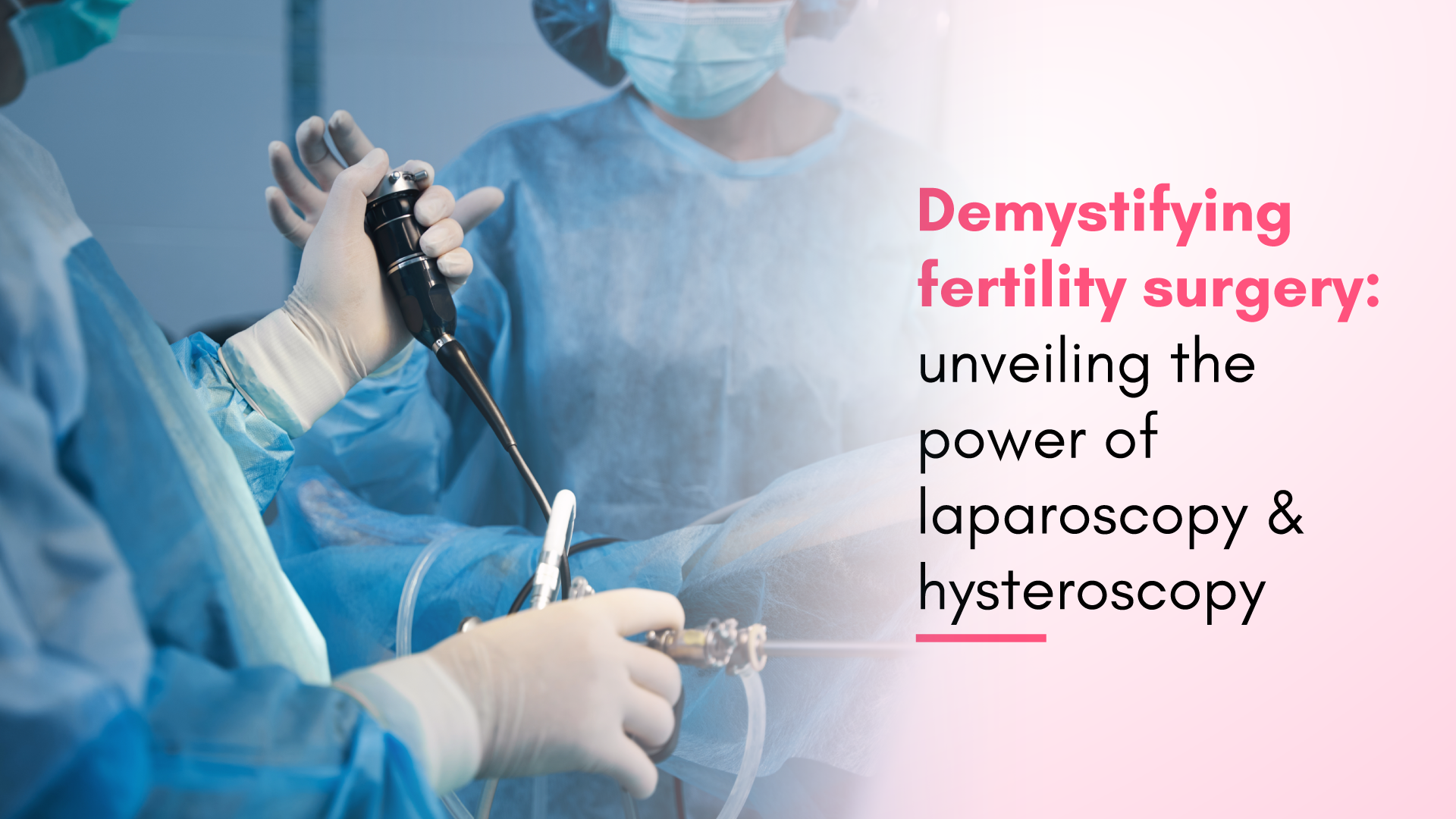Demystifying Fertility Surgery: Unveiling the Power of Laparoscopy and Hysteroscopy
Reviewed By: Dr. Jyothi C Budi - Medical Director at Ferty9 Fertility Clinic, Secunderabad, Hyderabad
Fertility surgery is a specialised medical procedure aimed at addressing various reproductive issues that may be hindering an individual's ability to conceive. These surgeries are performed by skilled and experienced fertility specialists at Ferty9 Fertility Center. Fertility surgeries play a pivotal role in improving fertility outcomes for those struggling with infertility.
Fertility surgeries can target a wide range of conditions in both men and women, from uterine abnormalities and ovarian cysts to blocked fallopian tubes and Varicoceles treatment and vasectomy reversal. By addressing these underlying issues, fertility surgeries can help restore normal reproductive function and increase the chances of successful conception, either naturally or through assisted reproductive technologies.
Related Read: How Can Couples Be Benefited From Laser Assisted Hatching?
Related Read: Facts About Assisted Hatching Reproductive Technology
What are the Different Types of Fertility Procedures?
When it comes to fertility surgery, doctors may recommend several common procedures. These include:
- Hysteroscopy
- Laparoscopy
- Myomectomy
- Dilation and curettage (D&C)
- Reversal of vasectomy procedure
- Varicocele treatment
- Sperm retrieval
Also Read: Procedure to follow male infertility testing
Let's explore each of these fertility procedures in more detail:
1. Hysteroscopy
Hysteroscopy is a surgical procedure that causes minimal tissue damage and allows doctors to examine the uterus with the help of a thin, lighted telescope-like instrument called a hysteroscope. This surgical procedure can help diagnose and treat various uterine conditions, such as:
- Uterine polyps
- Uterine fibroids
- Scar tissue (adhesions)
- Congenital uterine abnormalities
During a hysteroscopy, the doctor inserts the hysteroscope into the uterus through the cervix, allowing them to visualise the uterine cavity and make any necessary repairs or removals.
2. Laparoscopy
It is another type of surgical procedure that causes minimal tissue damage and allows doctors to examine the abdominal and pelvic organs using a small, lighted camera called a laparoscope. This procedure helps diagnose and treat conditions that may be contributing to infertility, such as:
- Endometriosis
- Uterine fibroids
- Ovarian cysts
- Pelvic adhesions
During a laparoscopy, the surgeon makes small incisions in the abdomen and inserts the laparoscope. The laparoscope transmits images to a monitor, allowing the doctor to visualise the internal organs and make necessary repairs or removals.
3. Myomectomy
This surgical procedure is performed to remove uterine fibroids, which are noncancerous overgrowths that can develop within the uterine wall. Fibroids can sometimes interfere with fertility, and a myomectomy may be recommended to remove them and improve the chances of conception.
4. Dilation and Curettage (D&C)
A Dilation and Curettage (D&C) is a procedure in which the doctor dilates (opens) the cervix and scraps or suctions out the uterine lining. D&C can help diagnose or treat various uterine conditions, such as:
- Abnormal uterine bleeding
- Uterine polyps
- Retained products of conception (after a miscarriage or delivery)
5. Vasectomy Reversal or Vasovasostomy
Vasectomy is a common and effective form of male contraception, but for some men, the desire to have children may arise later in life. Vasectomy reversal, also known as vasovasostomy, is a surgical procedure that can restore a man's fertility by reconnecting the vas deferens. They are the tubes that carry sperm from the testicles to the urethra.
The procedure typically takes 2-4 hours and is performed under general anaesthesia. During vasovasostomy, the surgeon will make a small incision in the scrotum and carefully reconnect the severed ends of the vas deferens.
6. Varicocelectomy
Varicoceles are abnormal dilations of the veins in the scrotum that can impair sperm production and quality. Varicocelectomy is a surgical procedure that involves repairing or removing these dilated veins, which can improve a man's fertility.
Your doctor performs this surgery under general anaesthesia, usually taking 1-2 hours to complete. During the surgery, the surgeon makes a small incision in the scrotum or abdomen and carefully identifies and ligates (ties off) the dilated veins.
7. Sperm Retrieval
For some men, the fertility issue may not be related to the vas deferens or varicoceles but rather a lack of sperm production or blockages in the reproductive system. In these cases, sperm retrieval procedures may be necessary to obtain viable sperm for use in assisted reproductive technologies (ART), like in vitro fertilization (IVF) or intracytoplasmic sperm injection (ICSI).
The following are different types of sperm retrieval procedures:
- Testicular Sperm Extraction (TESE): TESE involves removing a small sample of testicular tissue to extract sperm directly from the testes.
- Percutaneous Epididymal Sperm Aspiration (PESA): A surgeon uses a fine needle to aspirate (draw out) sperm directly from the epididymis. Epididymis is the coiled tube at the backside of the testicle where sperm is stored.
- Microsurgical testicular sperm extraction (Micro TESE): This technique uses a microscope to carefully extract sperm from the tiny tubules through a small incision in the scrotum.
- Testicular Sperm Aspiration (TESA): Similar to TESE, your doctor uses a fine needle to extract a small sample of testicular tissue to retrieve sperm in TESA.
Related Read: Expectations of Microscopic Treatment for Male Infertility
What to Expect the Day of Your Surgery
Before Your Procedure
Before any fertility surgery, patients will typically undergo a comprehensive evaluation, which may include:
- Medical history review
- Physical examination to examine your genitourinary tract (in men) or uterus and pelvic area (in women)
- Diagnostic tests (e.g., blood work, imaging studies)
You will also receive detailed guidelines on how to prepare for the procedure, which may include:
- Fasting for a certain period before the surgery
- Stopping certain medications
- Avoid smoking
- Arranging for transportation to and from the fertility clinic
During Fertility Procedure
During the surgical procedure, patients will be under the observation of a highly skilled and experienced team of Ferty9 experts, including the surgeon, anaesthesiologist, and nursing staff. The procedure steps will depend on the type of surgery being performed, but patients can generally expect the following:
- Anaesthesia administration: The medical team may induce general or local anaesthesia depending on the procedure.
- Insertion of the surgical instruments: Depending on the procedure, the surgeon may insert a hysteroscope or laparoscope through the incisions.
- Visualisation and examination of the uterine cavity, uterine lining, and fallopian tubes
- Performing necessary repairs or removals
- Closure of the incisions
After Fertility Procedure
After the surgical procedure, the medical team will closely monitor patients to ensure a smooth recovery. They will monitor:
- Monitoring vital signs
- Pain management
- Fluid and electrolyte replacement
- Instructions for post-operative care
Patients are typically discharged from the surgical facility once they have met the necessary recovery criteria and are provided with detailed instructions for continued care at home.
What to Expect: Post-Op Care
For Fertility Surgeries (i.e., Hysteroscopy or Laparoscopy or D&C Surgery)
After a fertility surgery, such as a hysteroscopy, laparoscopy, or D&C surgery, patients can expect to experience some mild discomfort, such as cramping or spotting. Doctors may also advise them to avoid sexual intercourse for some period to allow for proper healing. Patients will typically be prescribed pain medication and may be instructed to use heating pads or take over-the-counter anti-inflammatory medications to help manage any discomfort.
For Sperm Retrieval
After sperm retrieval, men may sometimes experience minor bruising and swelling of the scrotum. Surgeons may advise patients to rest for a day or two and avoid strenuous activity for at least 8 to 10 days. Doctors may also suggest pain medications to ease post-op pain and antibiotics to reduce the risk of infection.
Conclusion
Fertility surgery can be a highly effective way of helping individuals manage a wide range of reproductive issues, thus improving the chances of successful conception. By understanding the different types of fertility procedures, what to expect during the surgical process, and the post-operative care requirements, patients can feel more informed and empowered to make the best decisions for their fertility journey.
If you are struggling with infertility and are interested in learning more about fertility surgery options, we encourage you to schedule a consultation with a fertility specialist at Ferty9 Fertility Center. They can provide personalised guidance and help you determine the best course of action to achieve your family-building goals.
Visit Our Clinic:
Fertility Clinic in Hyderabad
Fertility Clinic in Visakhapatnam
Fertility Clinic in Vijayawada
Fertility Clinic in Karimnagar
Fertility Clinic in Warangal
Fertility Clinic in Rajahmundry
Fertility Clinic in Tirupati
Fertility Clinic in Kurnool

Write your message


